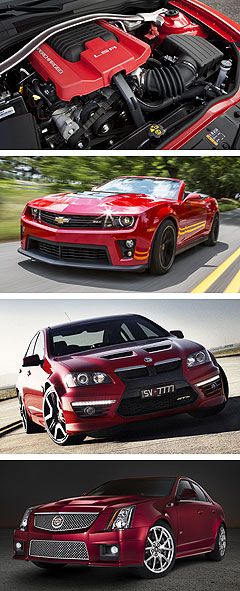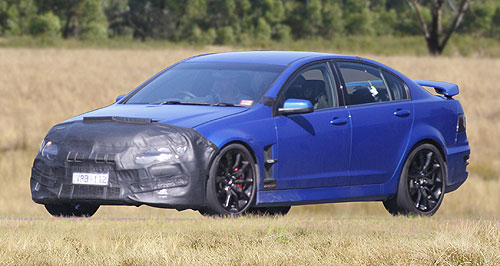Make / Model Search
Future models - HSV - F-SeriesHSV testing supercharged V8Fast future: A current-generation HSV E Series tests next-generation powertrain technology for the 2014 'F Series'. 4.0-second HSV on the cards as Camaro’s hot LSA V8 looms large for 2014 'F Series'9 Oct 2012 A TELLTALE whine from beneath the disguised nose of this Holden Special Vehicles (HSV) engineering mule under test in Victoria gives the best indication yet that Holden’s hot shop is working on the fastest, most powerful mass-production road car ever to wear the lion badge. Although HSV steadfastly declines to comment on its future-model program, GoAuto believes this current-generation HSV E Series ClubSport is running a new-generation General Motors supercharged V8 – most likely the same blown 432kW/754Nm 6.2-litre LSA engine as America’s Chevrolet Camaro ZL1. A slightly lower-output (415kW/747Nm) version also appears in the Cadillac CTS-V, which is still enough to make it the most powerful engine in Cadillac’s history. The LSA V8 is thought to be the frontrunner for the HSV ‘F Series’ due either in late 2013 or early 2014, boosting power and torque over HSV’s current 325kW/550Nm normally aspirated V8 in the flagship GTS and Grange models by more than 30 per cent. In the Camaro ZL1, the engine blasts the Australian-engineered coupe from zero to 100km/h in about four seconds – at least a second faster than the current HSV GTS (5.3 seconds) and rival Ford Performance Vehicles GT (5.2 seconds) – and on to a top speed of 294km/h.  From top: V8 engine from the Chevrolet Camaro ZL1 Chevrolet Camaro ZL1 2012 HSV GTS Cadillac CTS-V. From top: V8 engine from the Chevrolet Camaro ZL1 Chevrolet Camaro ZL1 2012 HSV GTS Cadillac CTS-V.Chevrolet claims the Camaro ZL1 achieved a supercar-like 7.41-minute lap of Germany’s Nurburgring Nordschleife circuit in production form earlier this year. The next-generation HSV range will be based on the new Holden VF Commodore that is due in showrooms about the middle of 2013 and which will be exported to the US as the Chevrolet SS Performance. Like the Commodore, the Camaro is built on the Australian-developed Zeta architecture, which is set to get major refinements for the VF Commodore, including lighter panels and suspension components. The new HSV F Series is set to share the same weight reduction technologies as the VF Commodore and Chevrolet SS. Some of these enhancements have already found their way on to the Camaro ZL1, which boasts an aluminium bonnet and electric-assisted power steering. While thinly disguised VF Commodores are out and about on Australian roads in the final stages of development for next year’s launch, HSV still appears to be in powertrain test and calibration mode using this current-generation car. Despite the car-bra disguise, the spy photo on this page reveals telltale indications of cutouts in the front fascia, opening up the grille for greater air flow into the engine for items such as an engine oil cooler, in line with the Camaro ZL1 which has a much wider lower aperture in the lower front fascia than the standard car. The aluminium-block LSA engine is said to be a development of the current LS3 engine used by HSV – and Chevrolet in US cars such as Corvette. The LSA version is pumped by a Roots-style sixth-generation Eaton supercharger sitting in the ‘V’ of the engine, drawing air through a low-restriction air filter. The balanced and lightweight engine internals include high-strength pistons, each with individual oil squirters for maximum cooling. The engine drives the rear wheels via a choice of a beefed-up Tremec six-speed manual gearbox – capable of coping with 30 per cent more torque than the unit used in current HSV models – or the latest Hydra-Matic six-speed automatic with three drive modes for normal, sport and ‘manual’ styles. Although the GM-supplied pictures of the Camaro ZL1 interior show no signs of steering-wheel-mounted paddle shifters, GoAuto understands that Chevrolet SS test cars under development in Australia have such quick-shift devices with the automatic transmission. The hot Camaro’s drivetrain has also been strengthened to handle the extra oomph, with a bigger limited-slip differential and asymmetrical half-shafts – a 60mm hollow steel shaft on one side and a 33mm solid shaft on the other to “minimise the chance of wheel hop”. Like current HSV cars, Brembo brakes are on offer, with six-piston stoppers on the front grabbing 370mm-diameter discs. And also like current HSV cars, the Camaro ZL1 has a bi-modal exhaust, magnetic ride control (but the latest generation) and launch control system for rapid getaways, but again only on the manual-gearbox-equipped model. If the engine makes it into series production at HSV, it will eclipse the company’s previous most powerful production car, 2008’s limited-edition 375kW/640Nm 7.0-litre W427. Only 138 W427s were built out of a proposed run of 427 units. It is unclear if HSV would go the all-supercharged engine route, in the same way as FPV with its locally developed Miami 5.0-litre blown V8, or instead keep the supercharged unit as a premium weapon, for GTS and Grange, for example. Even at 432kW, the LSA V8’s performance in Camaro ZL1 falls short of the 480kW of power and 802Nm of torque delivered by HSV sister company Walkinshaw Performance’s supercharger kit for HSV cars (or 460kW and 780Nm on the SS Commodore). However, this kit-enhanced engine is unlikely to make it into a series-production HSV model while an off-the-shelf supercharged engine is on offer from GM, complete with full factory warranty and full support from Holden.  Read more5th of October 2012  Walkinshaw Performance marks Bathurst 50thLimited supercharger kit for V8 Commodore as Walkinshaw marks Bathurst birthdayAll future modelsMotor industry news |
Click to shareHSV modelsResearch HSV All future modelsMotor industry news |



 Alfa Romeo
Alfa Romeo Abarth
Abarth Audi
Audi Aston Martin
Aston Martin BMW
BMW Bentley
Bentley Ferrari
Ferrari Chevrolet
Chevrolet Ford
Ford Fiat
Fiat GWM
GWM Foton
Foton Hyundai
Hyundai Honda
Honda Jaguar
Jaguar Isuzu
Isuzu Kia
Kia Jeep
Jeep Land Rover
Land Rover Lamborghini
Lamborghini Maserati
Maserati Lexus
Lexus McLaren
McLaren Mazda
Mazda Mercedes-Benz
Mercedes-Benz Mitsubishi
Mitsubishi Mini
Mini Peugeot
Peugeot Nissan
Nissan Ram
Ram Porsche
Porsche Rolls-Royce
Rolls-Royce Smart
Smart Skoda
Skoda Suzuki
Suzuki Subaru
Subaru Toyota
Toyota Tesla
Tesla Volvo
Volvo Zeekr
Zeekr







Facebook Twitter Instagram